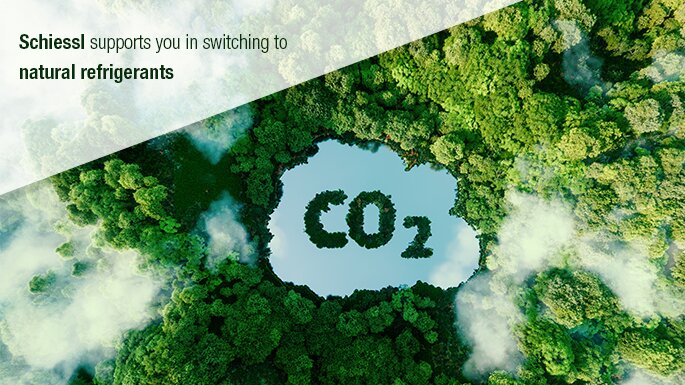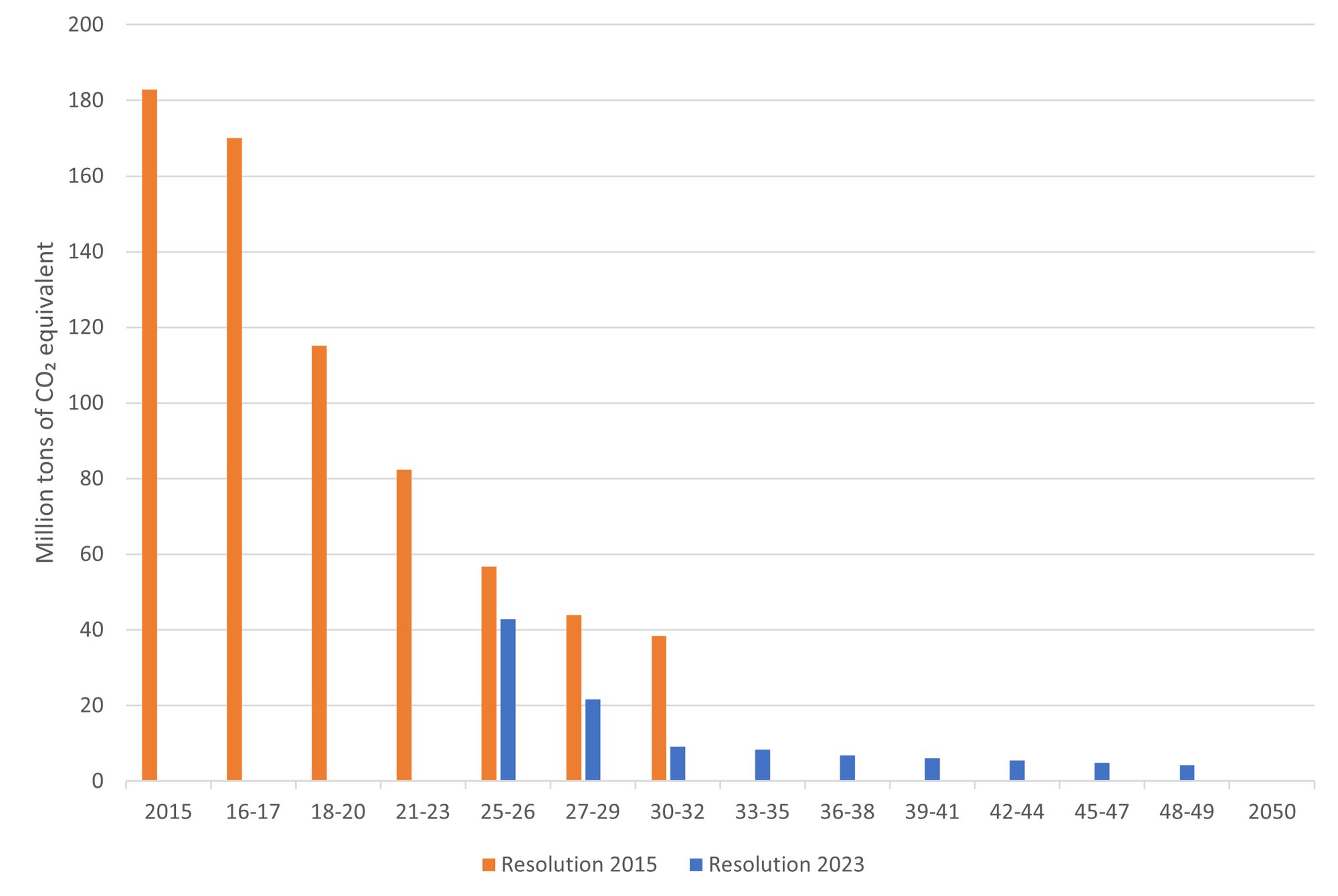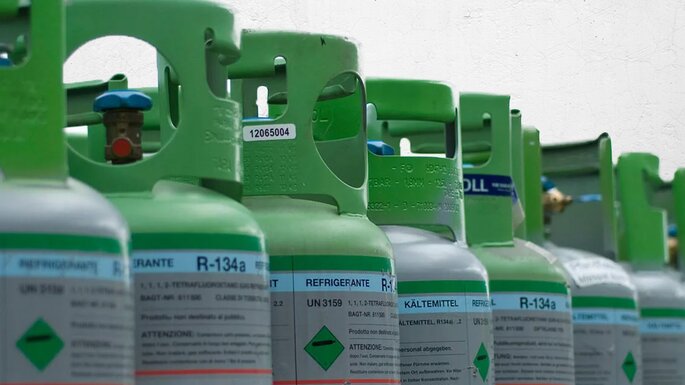- Service
- Refrigerants
- F-gases regulation
Revision of the Regulation on F-gases
The amended F-Gas Regulation (EU) 2024/573 comes into force on March 1, 2024. The EU Council previously approved the new regulation on 29.01.2024. The EU Parliament approved the trilogue proposal on 15.01.2024.
Our product range for future-proof CO2 systems

Information events 2024
Key points of the amended Regulation on F-gases:
- A further tightened phase-down of the available F-gases with a complete phase-out by 2050.
- A ban on the marketing of monobloc heat pumps and air conditioning units (up to 12 kW) with F-gases with a GWP greater than 150 from 2027 and a complete ban on F-gases for these products from 2032.
- A ban on the placing on the market of stationary refrigeration systems (exception: chillers) with F-gases with a GWP greater than 150 from 2030.
- Service and maintenance ban for refrigeration systems with F-gases with a GWP above 750 from 2032. This includes practically all common A1 refrigerants (exception: R513A). Recycled and reclaimed refrigerants are exempt.

As a result of these points, there must now be a rapid rethink in the planning of new systems so that the operator can also install systems that can be maintained and repaired without problems during a normal service life for such systems.
We already have many products in our portfolio that can be used to create long-term solutions. However, there will be many more products from manufacturers in the coming years, which means that our range will also undergo future-proof changes.
In terms of costs, we hope that manufacturers will be able to realize savings through the higher quantities of products with natural refrigerants in the future.
Timetable for placing on the market prohibitions and service bans
Placing on the market prohibitions of:
- Refrigerators and freezers for commercial applications (hermetic) with F-gases GWP > 150
- Stationary refrigeration systems (exception: chillers) with F-gases GWP > 2 500 (except equipment intended for applications for cooling products to below - 50 °C)
- Other self-contained refrigeration systems with F-gases GWP > 1501
- Split units with less than 3 kg capacity with F-gases GWP > 7501
Service ban on:
Refrigeration systems with F-gases GWP > 2500 (with fresh gas)
Placing on the market prohibitions of:
- Refrigerators and freezers for household applications (white goods) with all F-gases1
Service ban on:
- Air conditioning systems and heat pumps with F-gases GWP > 2500 (with fresh gas)
Placing on the market prohibitions of:
- Chillers with F-gases GWP > 150 up to a capacity of 12kW
- Chillers with F-gases GWP > 750 from an output of > 12kW1
- Split air-to-water air conditioning and heat pump systems with an output of up to 12 kW with F-gases GWP > 1502
- Plug-in monobloc air conditioning systems or plug-in heat pumps with an output of up to 50 kW with F-gases GWP > 1501
Placing on the market prohibitions of:
- Split air conditioning and heat pump systems with an output greater than 12 kW with F-gases GWP > 7502
- Split air-to-air air conditioning and heat pump systems with a capacity of up to 12 kW with F-gases GWP > 1502
Placing on the market prohibitions of:
- Stationary refrigeration systems (exception: chillers) with F-gases GWP > 1501
- Plug-in monobloc air conditioning systems or plug-in heat pumps with a capacity with F-gases GWP > 1502
Service ban on:
- Recycled and reclaimed refrigerant with F-gases GWP > 2500 (GWP 750 - 2500 unrestricted)
Placing on the market prohibitions of:
- Plug-in monobloc air conditioning systems or plug-in heat pumps with an output of up to 12 kW with all F-gases1
- Chillers with all F-gases up to an output of 12 kW1
Service ban on:
- Refrigeration systems with F-gases GWP > 750 (with fresh goods)
- Recycled and reclaimed refrigerant with F-gases GWP > 2500
Placing on the market prohibitions of:
- Split air conditioning and heat pump systems with an output greater than 12 kW with F-gases GWP > 1501
Placing on the market prohibitions of:
- Split air conditioning and heat pump systems with an output of up to 12 kW that contain F-gases2
1 Exceptions are only permitted if certain safety requirements must be met.
|
2 If safety requirements do not permit the use of fluorinated greenhouse gases with a GWP of 150 or less, then the limit GWP = 750 applies. Please note:
|
Phase-down process
Gradual reduction of the quantities of HFCs available on the market by 2050. Comparison of the resolutions from 2015 and 2023.
According to the resolution from 2023, the total available quota quantity of F-gases is to be reduced from to 74% in 2027 and 89% in 2030, in each case in relation to the 2023 quota.
 |
|

Questions about the Regulation on F-gases and its effects
1. What is the F-gas Regulation?
The Regulation on F-gases (EU) No. 517/2014 is a European Union law that aims to reduce emissions of fluorinated greenhouse gases (F-gases). These gases, which are often used in refrigeration and air conditioning systems and heat pumps, contribute significantly to climate change.
2. Which gases are covered by the F-gas Regulation?
The regulation mainly refers to the family of fluorinated gases, which includes HFCs (hydrofluorocarbons), PFCs (perfluorocarbons), SF6 (sulphur hexafluoride) and NF3 (nitrogen trifluoride).
3. What measures does the F-gas Regulation include?
The main measures include limiting the total amount of F-gases that can be placed on the market in the EU, rules on the use and maintenance of equipment containing F-gases, and requirements for the training and certification of specialized personnel.
4. How does the regulation affect refrigeration and air conditioning technology?
The Regulation will lead to a gradual reduction in the quantities of HFCs available in the EU. This forces manufacturers to develop and use alternatives with a lower global warming potential. Users will also have to adapt existing equipment or replace it with more environmentally friendly options.
5. What are the penalties for non-compliance with the F-gases Regulation?
The penalties for non-compliance can vary from country to country within the EU. They range from fines to criminal sanctions. In addition, companies that violate the regulation may face trade restrictions or loss of certification.
6. How does the F-Gas Regulation affect the import and export of F-gases?
The F-Gas Regulation lays down strict rules for the import and export of F-gases into and out of the European Union. Importers must apply for a quota in order to be allowed to import a certain quantity of F-gases. This also applies to products and equipment containing F-gases. The export of F-gases from the EU is also subject to certain restrictions and must be reported.
7. What alternatives are there to the gases affected by the F-Gas Regulation?
Substances with a lower global warming potential (GWP) are increasingly being developed and used as alternatives to traditional F-gases. These include natural refrigerants such as ammonia, carbon dioxide (CO2) and hydrofluoroolefins (HFOs), which have a significantly lower GWP. These alternatives often require adjustments to the design of refrigeration and air conditioning systems, but offer more environmentally friendly and sustainable solutions in the long term.
8. Are there special regulations for the maintenance of systems containing F-gases?
Yes, the F-Gas Regulation stipulates that systems containing certain quantities of F-gases must be checked regularly for leaks. The frequency of these checks depends on the type and quantity of F-gas used. In addition, repairs to leaks must be carried out immediately and the maintenance work carried out must be documented.
9. How does the F-Gas Regulation affect existing installations?
Existing installations containing F-gases can continue to be operated as long as they comply with the requirements of the regulation. This includes regular inspections and maintenance. However, older systems that are operated with F-gases and are affected by the phase-down may find it difficult to procure substitutes. In the long term, this could lead to system owners deciding to replace or convert to alternative refrigerants.
10. What impact will the F-Gas Regulation have on the development of new technologies?
The regulation promotes the development and introduction of technologies that use less or no F-gases. This has led to a surge in innovation in the industry, with companies investing in more environmentally friendly solutions. This includes not only new refrigerants, but also improved technologies to increase efficiency and reduce overall greenhouse gas emissions.



